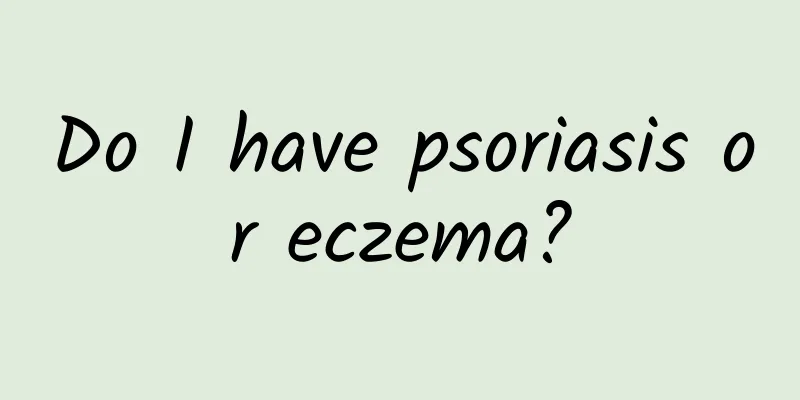Do I have psoriasis or eczema?

|
This is the 4369th article of Da Yi Xiao Hu Psoriasis is a common dermatological disease. Its physical itching, psychological trauma and multiple systemic complications seriously affect the quality of life of patients. What's worse is that some doctors diagnose it as psoriasis, while some diagnose it as eczema. So is it psoriasis or eczema? Characteristics of skin lesions of psoriasis and eczema[1-2] Psoriasis often gets worse in winter. At present, psoriasis is generally divided into four types according to clinical manifestations: common type, pustular type, erythrodermic type and arthritic type. Among them, common type is the most common, with characteristic skin lesions as red papules or plaques with clear boundaries, covered with thick silvery white scales, and characteristic light red translucent film under the scales. Petechiae can be seen when the film is scratched. The peak season for eczema is spring and summer. In the acute phase, the skin lesions are polymorphic, starting with diffuse flushing and then developing into papules, blisters, erosions with exudate, crusts, etc., and multiple skin lesions often exist at the same time; while in the chronic phase, the lesions are limited to certain parts, such as the back of the hands, calves, elbows, scrotum, etc., and the skin is thickened and lichenified. What is eczematous psoriasis? Eczematoid psoriasis is not eczema, but psoriasis with "eczema" as the main clinical manifestation. The characteristics of skin lesions are more diverse, with overlapping manifestations of psoriasis and eczema. The specific manifestations are severe itching, the boundaries of skin lesions are not obvious, and they can occur anywhere on the body. There are erosions or exudates, and they appear as moist eczema or coin-shaped eczema. Frequent scratching will aggravate the erosions, forming a vicious cycle [3]. Some patients experience alternating symptoms of "psoriasis" and "eczema". In this case, we can regard the body's immune-related inflammation as an axis. On one side of the axis are typical psoriasis-like lesions. Under the influence of certain factors, such as lifestyle, diet, and medication, when the axis tilts to the other side, eczema-like changes will occur [4]. This is why some psoriasis patients find that their skin lesions have changed and wonder if they were misdiagnosed at the beginning. What are the differences between psoriasis and eczema? 1. Psoriasis is often accompanied by a family history of allergies; and patients with chronic eczema often have allergic constitutions, which may be hereditary and are often accompanied by a history of allergic diseases such as urticaria, asthma, and allergic rhinitis. 2. The surface of psoriasis vulgaris is often covered with silvery-white scales, which is also the origin of the name of psoriasis; while chronic eczema is accompanied by pigmentation, and scales may also appear on the surface, but they do not appear white. 3. Psoriasis can sometimes affect the nails, joints, and even the internal organs; whereas chronic eczema does not show any signs of damage to the body system. Treatment of psoriasis According to the latest Chinese psoriasis diagnosis and treatment guidelines, mild psoriasis is mainly treated with topical medications, while moderate to severe psoriasis can be treated with phototherapy, systemic medications or biological agents. The combination of Chinese and Western medicine is advocated. Topical treatments include glucocorticoids, vitamin D3 derivatives, retinoic acid, calcineurin inhibitors, etc.; narrow-band ultraviolet light is often used in phototherapy, which is suitable for moderate to severe psoriasis vulgaris, and should be used with caution in erythrodermic and pustular psoriasis. Systemic drug treatments include retinoic acid, methotrexate, cyclosporine, etc. Cyclosporine has a rapid onset of action but is generally not used for maintenance treatment. Methotrexate still has advantages over other drugs; biological agents can be used for moderate to severe psoriasis, which are effective but relatively expensive [2]. In traditional Chinese medicine, psoriasis is called "white psoriasis". It is mostly caused by deficiency of blood and nutrients, internal heat in the blood, dryness and wind generation, and malnutrition of the skin. In the progressive stage of the common type, the basic treatment principle is to clear away heat, cool blood and detoxify. In the quiescent stage, the basic treatment principle is to nourish blood, nourish yin and moisten dryness or to promote blood circulation, remove blood stasis, detoxify and dredge meridians. In clinical practice, the treatment is dialectical and the drugs are added or subtracted according to the patient's own conditions. Acupuncture, ear acupuncture, cupping and other combined treatments can also be used [5]. Prevention and care 1. Prevent infection and trauma; 2. Do not over-stimulate the skin in the progressive stage or erythroderma type; 3. Quit smoking and drinking, relax your emotions, eat in moderation, and have a regular daily routine. References: [1] Zhang Xuejun. Dermatology and Venereology. 9th edition[M]. People's Medical Publishing House, 2018 [2] Zeng Yueping. Andrews' Dermatology (11th Edition)[J]. Peking Union Medical College Journal, 2012, 3(04): 493. [3] Wang Dixin. Clinical and immunological characteristics of eczematoid psoriasis[D]. Shanghai Jiaotong University, 2017. [4] Zhu Shengjie, Feng Xinyi, Guo Dongjie, Li Bin, Li Fulun. Thoughts on the treatment of psoriasis and atopic dermatitis with traditional Chinese medicine under the inflammatory model[J]. Chinese Journal of Traditional Chinese Medicine, 2020, 35(12): 5953-5956. [5] Chen Xi, Zeng Yajun, Li Lingling, Duan Xingwu, Zhou Lin, Zhang Runtian. The evolution of TCM syndrome differentiation in psoriasis[J]. Chinese Journal of Integrated Traditional and Western Medicine Dermatology and Venereology, 2017, 16(06): 560-564. Author: Yueyang Hospital of Integrated Traditional Chinese and Western Medicine affiliated to Shanghai University of Traditional Chinese Medicine Xi Ruofan, Li Fulun Illustration: Zhu Jingyi |
<<: Home care for children's anal dilation
>>: What is mucopolysaccharidosis?
Recommend
What should girls pay attention to when they grow up?
Adolescence is a green but awkward period. With t...
Handset Detection: Android device usage around the world – Infographic
Although Android's growth rate has declined i...
What causes leg cramps in late pregnancy?
Having a baby is a truly happy thing, but mothers...
Woman wakes up with swollen eyelids in the morning
The symptom of eye swelling is more obvious and w...
What is the cause of a pimple on the vulva?
Women are always a vulnerable group, especially u...
Enlarged clitoris
Sexual excitement is something that every adult h...
Where should I get moxibustion for excessive leucorrhea?
Leucorrhea is the secretion from the female vagin...
My calf is sore and swollen when my period comes
Menstruation is a physiological need unique to wo...
What not to do during menstruation
Menstruation is a physiological phenomenon that e...
Do you know? Open the door┋There are many types of food poisoning, please save the prevention guide!
Contributing expert: Li Caihong, Urumqi First Peo...
What materials should be used for the bedroom headboard background wall? How to decorate the bedroom headboard background wall without going out of style?
We all know that the bedroom is a very important ...
What to do if you have bleeding at 33 days of pregnancy
Generally, the first three months of pregnancy ar...
Do rabbits have hair when they are born? Why are the little rabbits shaking all over?
Rabbits are not very big, and the babies they giv...
What to do if there is no fetal heartbeat at 8 weeks of pregnancy
When the egg cell and sperm meet and fuse to form...
What is the 0 next to the gear position of BYD Song? How to open the trunk of BYD Song from inside the car
BYD Song is loved and chosen by everyone for its ...









